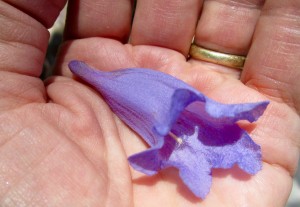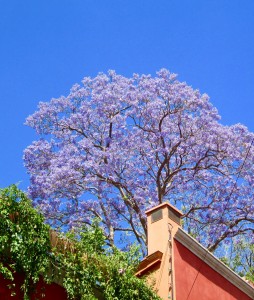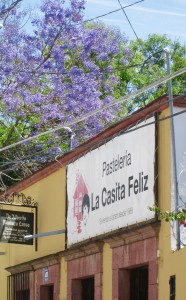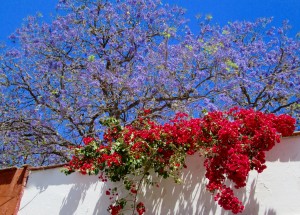When I lived in southern Africa in my mid-twenties, I learned that springtime was known as “jacaranda time.” Majestic jacaranda trees lined the broad avenues of the capital (then Salisbury, Rhodesia, now Harare, Zimbabwe) and came into bloom in October and November each year – springtime in the southern hemisphere.
The city of Salisbury, when I lived there, from 1969 to 1972, was rightly and proudly known as “the city of flowering trees.” There were flame-red flamboyants, delicate-pink mimosas, and sunny-yellow cassias, among many other colorful tropical flowering trees, lining the streets. But I was most captivated by the jacarandas.
Growing up in New Jersey, I’d loved the dazzlingly colorful fall foliage, and the fragile, Eastertime-flowering dogwood tree in our front yard. But I’d never seen trees like these jacarandas in southern Africa: toweringly tall and strong, like oak trees in their regal bearing; yet, when in bloom in October, fancifully dressed in frilly gowns made of pale-purple, bell-shaped flowers.
Then, in November, as I wrote in my memoir of that time and place, “when the rainy season began, the purple bells fell along the wet sidewalks, mirroring the glamor of the trees” (Somewhere Child, Viking Press, 1981).
What impressed me most and inspired me then about these jacarandas was the juxtaposition of their soaring strength and their seemingly fragile beauty.
Now, here I am, nearly five decades later, in the central mountains of Mexico in early spring. And what do I find? It’s jacaranda time! I feel as if I’ve come full circle.
In April and May (springtime in the northern hemisphere) the beautiful colonial city of San Miguel de Allende is dotted with an added color on its already color-filled palette – purple jacaranda (pronounced “HACK-ah-ronda” here) trees in bloom. Now, on my daily walks and explorations, I take pictures of these glorious trees wherever I go:
Returning home from a recent walk, I did a little research (thanks again to Google, which didn’t exist when I lived in then-Salisbury) and learned that jacaranda trees, native to South America, have been planted widely in Asia, South Africa, Zimbabwe, Australia, and other tropical and subtropical regions. Obviously, being tropical trees, they don’t like cold weather. (I can relate.) “Small Jacaranda trees can grow in shade, but more mature trees need more sun,” I read.
And here’s the most relevant and inspiring takeaway for me:
“Only older jacaranda trees will bloom.”
Yes, age can certainly be a plus after all.






Nice piece, Bonnie! I’ve always loved jacarandas, though never seen enough of them having lived in cold, dry climates my whole life. I must say that your writing has blossomed, too, living in Mexico.
Thanks so much, Barb! You’d love seeing these jacarandas “in person.” Can’t wait for you to come and visit! — xx
I too look forward to the huge jacaranda tree that blooms in my garden each year. Did you know that the monarchs usually come through heading north when the jacarandas are blooming. Not this year though. Usually my three story high jacaranda is covered with monarchs in mid-March……
I did not know they have them in South America and Africa. I do know they are prolific in Barcelona! And Mexico City among other places. Thanks for the post……..
My pleasure, Babs! I’m going to a lecture at the Biblioteca on Wed. at 3 pm on monarch butterflies. Maybe you’d like to meet me there to learn how/why their patterns have changed?
Oh Bonnie…as usual you tie up your lovely essay with a sudden truth that leaves me gasping! “Only older jacaranda trees will bloom”. OK…they are my new favorite tree! Like all my favorite older women here in San Miguel…blooming extravagantly!
Pamela dear — I can always count on you to “get” my main point. Thank you so much. Yes, I too see many older women here in SMA who are blooming extravagantly.
How beautiful they are, and what beautiful photos. I love reading all of your posts. We can all continue to bloom no matter what our age or circumstance.
Thank you, Barbara. Yes, so true — we can all keep blooming.
Beautiful and vivid! Thanks for the glimpse of the color of your new surroundings and for the reminder of the historical ties.
Thanks so much for your feedback, Bob. Yes, our history comes with us, wherever we go….
Quick question, I live in San Antonio Tx and I got 4 jacaranda trees. They were maybe 3 inches when I got them and now they’re about 5 ft tall. Last week it got really cold (low 30’s) all the leaves on all four trees got brown, are the trees dying or is that normal? Last winter that didn’t happen, well, it didn’t get that cold either. I would appreciate any help.
Thank you!!
Hi Bonnie,
I live in Sydney, born in Kenya. Have been in love with jacarandas since I arrived here, as are many Australians. i am currently writing an essay on jacarandas, and google had brought me to yours, for which i’m grateful. Our winding journeys through life can be so poignant, and enjoyed reading of your travels and meetups with jacarandas in the various countries that you’ve lived in.
I also found out thanks to google research that jacarandas are plentiful in Kenya in nairobi, the capital. Sadly I never saw them as I hardly visited, being from coastal Mombasa.
Thanks for your thoughts, especially your takeaway at the end!
Dear Zohra — How lovely to hear from you, all the way from Sydney! I’ve often wondered why my “Jacaranda Time” post still gets so many readers. Maybe many students around the world write essays about beautiful jacaranda trees. 🙂 Best wishes with your essay. And THANK YOU for writing. Abrazos (hugs) from Mexico.
It is 9 May 2023 and the blue Jacaranda trees ae in full flower here in Malaga. Beautiful indeed!
Thank you for this, Roger. Enjoy Malaga!